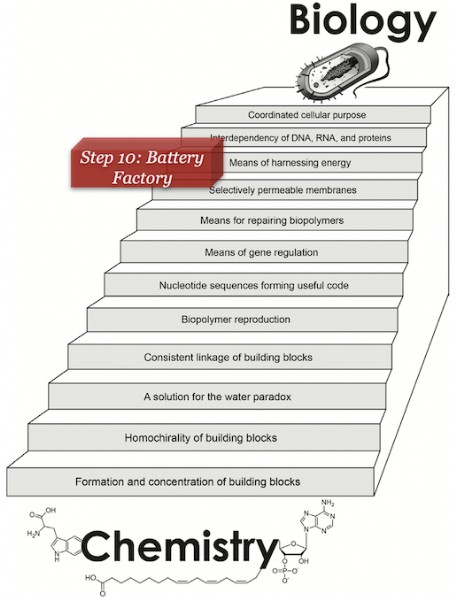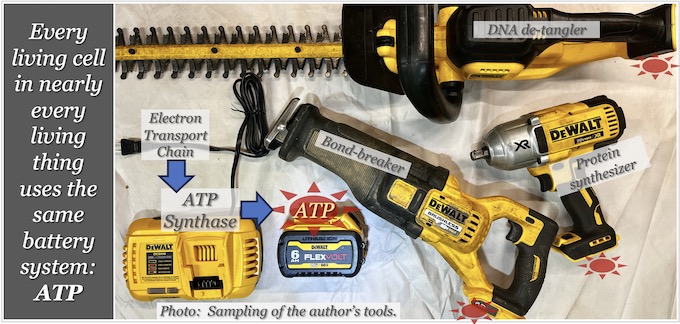A basic question has to be asked. Once a cell has amino acids to form proteins, DNA and RNA to replicate instructions which build the cell, a protective membrane, and so on – where does the cell get all its energy? How does it harvest power from outside the membrane, safely bring it in, then distribute it into a wide variety of molecular motors performing different functions?
It turns out that God energizes every living cell in nearly every living thing with the same source: ATP. The body’s ability to harness energy is another wondrous step on the stairway to life, for which evolutionists have no viable explanation. Complex yet elegant, it’s rightly compared to the utility which engineers recently created in the 20th century: electrical wall outlets, battery chargers, and batteries.
Let’s start with the wall outlet; we use 110 Volts, but the cell runs much higher. Harnessing energy requires a series of complex yet tightly arranged proteins called the electron transport chain (ETC). Its goal is to produce a voltage difference, just like the electric socket in your wall. ETC strips electrons from carbon found in food sources (e.g., carbohydrates, proteins, fats). The only waste products are carbon dioxide and water. It’s built to narrow tolerances, since handling electrons is like passing a hot coal – electrons must move quickly through a complex path. ETC uses technology which even our power grid doesn’t have. According to Dr. C.L. Tan, ETC’s “process involves electron tunneling, a quantum phenomenon that occurs over distances of only a dozen or so Ångströms (approximately the diameter of one hydrogen atom). … The successive steps in the ETC pathway align to within 10 Å of each other.” If spaced further apart, an electron would break loose and create free radicals which damage neighboring cells. (The cell detects when there’s too many free radicals, then safely disassembles and dies to prevent further injury.) The ETC efficiently transports electrons to make a cell wall’s voltage potential around 0.15–0.20 volts. This may seem small, but it’s equivalent to 30 million volts per meter, similar in strength to a lightning bolt!
Now that the cell has an electrical outlet, the ATP “battery” gets charged. Enter the ATP synthase, a super-efficient electrical nanomotor that turns 7,800 rpm. With each rotation, three fully-charged ATP molecular batteries are produced, ready for distribution and use.
ATP is a universal battery, powering a wide array of molecular machines (see photo below). ATP is used for: “activating amino acids for protein synthesis, copying DNA, untangling DNA, breaking bonds, transporting molecules, and contracting muscles. … A human body contains only about 60 grams of ATP, [with] estimates that humans regenerate approximately their own weight in molecules of ATP every day.” If only I had a such a battery to run my tools, house and car!
Evolutionists strain to find sensible explanations as to how all of life is powered by ATP. In their view, this capability (power outlet, battery charger, and battery) had to arise early in evolution. Their best ideas assume the simpler energy systems of micro-organisms near ocean floor hydrothermal vents just got more complex. Many evolutionists still call it a mystery. The obvious answer is that finding a universal battery system which powers all life signifies a great design.
Again we find He hath done all things well. He is the Christian’s sole source of power, for in Him we live, and move, and have our being.
Source: Dr. Change Laura Tan and Rob Stadler, The Stairway To Life: An Origin-of-Life Reality Check, Evorevo Books, 2020, chapter 16.
Like this? Consider sharing it to Facebook by clicking the linked icon below.
